Microsoft’s new Surface Laptop 3 is a big leap from its predecessors, while the second-generation was a mere spec bump. As with any Surface product, we know that the third-generation is sort of the defining generation, where a product has reached maturity. Just look at the Surface Pro 3, which was bigger and thinner than its predecessors.
I haven’t reviewed the 13.5-inch model, as much as I’d like to. But I’ve seen how the weight has been redistributed, and while the chassis mostly looks the same, it’s been reengineered.
The big deal is that there’s now a 15-inch model, and that’s the one that I’m reviewing. As has always been the case, the Surface Laptop 3 is made out of aluminum, a heavier but more premium-feeling material than the more traditional magnesium that we see in Surfaces. Moreover, there’s no Alcantara fabric coating on the keyboard deck with the 15-inch model, although it’s an option for the 13.5-inch one.
The other thing that’s quite significant is that Microsoft diversified the chip vendors for this lineup of Surface products. The Laptop 3 15 comes with custom AMD Ryzen Surface Edition chips, although both the 13.5-inch model and the Surface Laptop 3 15 for Business use Intel Ice Lake.
Specs
| CPU | AMD Ryzen 7 3780U Surface Edition |
|---|---|
| Graphics | Radeon RX Vega 11 Graphics Microsoft Surface Edition |
| Display |
15” PixelSense Display |
| Body | 13.4x9.6x.57” (339.5x244x14.69mm), 3.4 pounds |
| Memory | 16GB DDR4 RAM |
| Security |
Firmware TPM |
| Storage | 512GB removable SSD |
| Battery life | Up to 11.5 hours of typical device usage |
| Ports | (1) USB Type-C (1) USB Type-A (1) Surface Connect 3.5mm combo audio jack |
| Cameras, video, and audio |
Windows Hello face authentication camera (front-facing) |
| Wireless | Bluetooth Wireless 5.0 technology Wi-Fi 5: 802.11ac compatible |
| OS | Windows 10 Home |
| Material | Aluminum |
| Color | Matte Black |
| Price | $2,099 |
Day one
Design
I've never tried to hide the fact that I didn't like Surface PCs. And when Microsoft announced this generation of Surface products, I wasn't shy about saying that I think this is the first generation of actually good Surface PCs. The big problem was always the lack of USB Type-C ports. Sure, the Surface Laptop 2 was fine, but how could I possibly recommend spending over a thousand dollars on a PC when you can get one with more modern technology?
As a reviewer, it's an issue. I have to look at things with a perspective of knowing what else is on the market. I can't tell you that you should purchase something if I know that there's something better available for the same price. Luckily, I don't have to worry about that anymore, as all Surface products have a USB Type-C port.

On to the Surface Laptop 3. As usual, it comes in aluminum, but that doesn't mean it's the same. The 13.5-inch model comes in more of a variety. You can still get it in Cobalt Blue or Platinum with the Alcantara fabric keyboard, or you can get it with a metal deck in Black or Sandstone. The 15-inch model only comes with a metal keyboard deck, and it only comes in Platinum and Black.
Personally, I think Black is the winner, at least on the 15-inch model. Both the Sandstone and the refined Cobalt Blue look amazing on the 13.5-inch version; I do miss Burgundy though. Platinum looks boring to me, although I do know that there's a market for silver laptops. When HP announced the new version of the Spectre x360, it had to bring back its silver model by popular demand, so people do want it.
The lid is stamped with a glossy Microsoft logo, as has been the branding on Surface products for a few years now. It will match whatever color you buy the laptop in.

As far as ports go, the only thing that has changed is that the Mini DisplayPort is now a USB Type-C port. It's in the exact same spot, and it's also aligned in the same way. Microsoft is all about maximizing compatibility with existing peripherals, so that's why it hasn't moved. On the left side is also a USB Type-A port and a 3.5mm combo audio jack.
Interestingly, Microsoft doesn't actually publish what kind of USB is being used, but it's definitely not Thunderbolt 3. The lack of the feature doesn't stand out as much with the 15-inch Surface Laptop 3 though, since this is an AMD machine. Thunderbolt is an Intel thing, and while OEMs can add a controller on AMD and Qualcomm PCs, it's very rare.

On the right side, the Surface Connect port is exactly where they left it. Surface Connect should still be USB 3.1 Gen 1, allowing for 5Gbps data transfer. It's my understanding that the USB Type-C port, however, is USB 3.1 Gen 2, for 10Gbps.
There's one more thing that you should be aware of, which is that the storage is removable. Yes, that means that you can upgrade your storage, or securely destroy it when recycling your PC. Microsoft charges an insane $300 premium just for going from 128GB to 256GB when configuring a Surface Laptop 3, so the upgradeable storage could come in handy when you can actually get a 512GB SSD for far less than that.
Here's the deal though. Microsoft says that it's not user-removable, meaning that the company doesn't want you to do it by yourself. It's easy enough; you just have to pry off the rubber feet under the laptop and remove four Tox screws. But if you do it, Microsoft's not responsible for if you damage your PC, if you have trouble getting the PC to recognize the new drive, or anything else that might occur when replacing storage.
It's nice that the option is there though. With the rise of smartphones, tablets, ultra-thin PCs, and so on, it's nice to have at least some level of easy reparability.
Display and audio
The screen on the Surface Laptop 3 15 is exactly 15 inches, rather than the 15.6 inches that you traditionally see on laptops branded as 15-inch. Of course, this is completely custom because it's 3:2, and it has a 2496x1664 resolution, giving it a 201ppi pixel density. It's the lowest pixel density of any portable Surface, with the Surface Go coming in at 217ppi and the Surface Pro 7, Pro X, and Book 2 coming in at 267ppi.

The only Surface that has a lower pixel density is the Surface Studio 2, at 192ppi. All of these screens have custom resolutions, meaning Microsoft isn't just buying some off-the-shelf part. The team is deciding on what it thinks is right for the product. Typically, lower pixel densities make more sense in devices that are further away from your eyes, like in a desktop PC. I'm not sure why the Surface Laptop should have a lower pixel density than the Surface Book, but it's possible that it's because you can detach the display on the Book and use it as a tablet.
Either way, both the pixel density and the resolution are fine. You won't notice any pixellation on this device, unless you get really close to the screen. The colors are accurate too, although that's no surprise. Microsoft has been really good at making displays even since the very early days of Surface. Various Surface products have had their ups and downs, but one thing that's always been great is the screen on the device.
One thing that I really want to say about the display is that I feel like it's the perfect size. It's not as bulky as a standard 16:9 15-inch laptop because it's not as wide, and it's not as thick either. Weighing in at 3.4-pounds and coming in at 14.69mm thick, Microsoft isn't targeting the dedicated GPU/45W CPU market like many 15-inch laptops do. This is an ultrabook with a big screen, and the 3:2 aspect ratio makes me feel like there's plenty of space. I've not felt that way on the 12-, 12.3-, 13-, and 13.5-inch 3:2 displays that I've used on Surface devices, so I really do love this 15-inch size. With the smaller sizes, I've always felt like it was cramped when running two apps side-by-side.
Part of the reason that I feel like it's the perfect size is that the screen is about the width of a 14-inch 16:9 laptop. That gives me the space I need to work, and then it's just taller.

The 15-inch screen does support touch, and it has pen support as well, using Microsoft's N-Trig. There's no way to attach the pen to the Surface Laptop 3, but that's OK. Inking isn't really something that you'd do with a clamshell like this, but that's nice is that the option is there if you need it.
One other thing I'll note is that the bezels are a bit large for something made in 2019. It's not particularly noticeable or anything, but they're there. Microsoft does include a webcam and an IR camera above the screen,, so you do get facial recognition out of it.
And on a side note, Microsoft's facial recognition in its first-party hardware is really good. Quite a few third-party PCs that I've used have struggled with accuracy or with launching the camera quickly on the lock screen, but Microsoft's first-party experience is always top-notch.
Audio quality is pretty good too. I can appreciate how clear they are, and how loud they are, considering that it doesn't even have a visible speaker grill. The speakers are actually under the keyboard, so the sound still fires up at you.
Keyboard and trackpad
I've never been a big fan of the keyboard on the Surface Laptop. Don't get me wrong; it's fine. But the keys feel a little plasticky, and it just doesn't feel as premium as some other PCs that I review. And remember, I review a lot of PCs, so this thing is competing against the best. Still, I'd take a Surface Book keyboard over this any day.

The key depth and resistance feels fine, and it's accurate too. It does check the right boxes, and if you buy one, you'll probably wonder what the heck I'm talking about. There are just better keyboards out there, such as in HP's EliteBooks and Lenovo's ThinkPads.

One thing that I really like about it is that there's no numeric keypad on the side, something that's all too common on 15-inch laptops. This is likely because the display is really only about the width of a 14-inch 16:9 laptop, but I'll take the win. I hate numeric keypads, possibly just because I'm not used to having them.

The trackpad uses Microsoft Precision drivers, as you'd expect from a device from Microsoft. It's definitely one of the better trackpads out there, being fast and responsive. It's big enough, although as I'm so fond of pointing out with trackpads, it could be bigger. I always want OEMs to use up every possible bit of real estate that it can.
One thing that I absolutely hate is how loud the trackpad is, and it's the same with most of Microsoft's PCs. If you're using it in a perfectly quiet room, it's almost embarassing.
Performance and battery life
The Surface Laptop 3 15 that Microsoft sent me includes an AMD Ryzen 7 3780U Microsoft Surface Edition processor. It's a 12nm CPU has a 15W TDP, four cores, and eight threads. It also has Radeon RX Vega 11 Graphics, with 11 GPU cores clocked at 1400MHz.
One thing that Microsoft did this year with its Surface lineup is it diversified the processors used in its products. Other than the Surface RT lineup, everything has used Intel. This year, the Surface Pro 7 has Intel Ice Lake, the Surface Pro X has a modified Snapdragon 8cx, and the Surface Laptop 3 has Intel Ice Lake in the 13.5-inch model and AMD Ryzen in the 15-inch variant.

I appreciate AMD and Qualcomm; I really do. I like it when Intel has some competition, and I like it when every PC I review doesn't have the same hardware inside of it over and over.
But that doesn't mean it's good for you. In applications like Adobe Photoshop and Premiere Pro, you can feel the difference between the Surface Laptop 3 and say, the Dell XPS 13 2-in-1 with Intel Ice Lake. I'm not saying its bad by any means, but I am saying that Intel Ice Lake is better. Moreover, Microsoft actually makes a 15-inch Surface Laptop 3 with Ice Lake CPUs; it's called the Surface Laptop 3 for Business, and it's a bit more expensive because it comes with Windows 10 Pro instead of Home. I think that's the one you should get.
For benchmarks, I used PCMark 8 and PCMark 10, as usual.
| PCMark 8: Home | PCMark 8: Creative |
| PCMark 8: Work | PCMark 10 |
You're probably better off comparing these scores to something with Intel's eighth-generation 'Whiskey Lake' processors, such as last year's Lenovo ThinkPad X1 Carbon. If you look at the Dell XPS 13 2-in-1, it got 3,795 on Home, 4,194 on Creative, 3,723 on Work, and 4,441 on the PCMark 10 test, winning in each one.
Intel Comet Lake, the 14nm version of its 10th-gen lineup, which doesn't even have Iris Plus graphics, also wins. The Dell XPS 13 got 3,501 on Home, 3,966 on Creative, 3,342 on Work, and 4,314 on PCMark 10.
One more PC that I'll compare it to is the Surface Pro 7 that Microsoft sent me, which has a Core i5-1035G4. It's just an i5, and it's just the G4 version of Iris Plus graphics, rather than G7. It scored 3,376 on Home, 3,749 on Creative, 3,339 on Work, and 4,030 on PCMark 10. It barely beats out the Ryzen 7 that we have here.
Again, I hate to make it sound like AMD's Ryzen 3000 U-series processors are bad, but when reviewing a product, I have to look at what the rest of the market offers. And Intel's products win in every way.

As far as battery life goes, it's some of the best that you'll find in a 15-inch laptop, and that's good and bad. In general, 15-inch laptops don't get great battery life to begin with, and that's mainly because they tend to have 45W processors and dedicated graphics. It's a low bar. Microsoft claims that it gets about 11.5 hours of battery life in "typical usage", and that still depends on what you're doing and how bright the screen is.
I found that in actual real-world usage, I got about six hours. That's six hours with battery saver kicking on after 20%. It does support fast charging now, assuming that the lid is closed. It also comes with a 65W Surface Connect charger, which is new. Typically, most Surface devices have historically come with 45W chargers.
Conclusion
Despite its flaws, I really do like the Surface Laptop 3 15. I feel like the display is the perfect size. As I said earlier, I've never cared much for 3:2 displays, because they tend to not be as wide as 16:9 screens, and I need apps to run side-by-side. But this screen is the width of a traditional 14-inch laptop, which makes it fine; it's just taller, giving me extra real estate.

Now, for the bad. For me, the biggest negative aspect of the Surface Laptop 3 is that loud trackpad. I can deal with everything else, but when I'm in a quiet room, I need to be able to be quiet. Microsoft does love its clicks though. The other thing, which is the sort of elephant in the room, is that Intel's Ice Lake is simply better than the AMD Ryzen processors that Microsoft used here. If you buy a Surface Laptop 3 for Business, that's not an issue for you.
There's something about the Surface Laptop 3 that just feels good to use. It's a very well-designed machine, as Surface PCs tend to be. As Microsoft likes to point out, you can lift the lid without one finger, and you don't have to hold down the base.
It's also slim and light for a 15-inch laptop, with a sexy matte black design (or platinum, if you get down like that). All-in-all, this is a pretty great PC, if you're looking for a 15-inch ultrabook. Or, frankly, it's a great PC if you're looking for a 14-inch ultrabook with a taller screen. It just works well; I'd just recommend grabbing the business model instead.



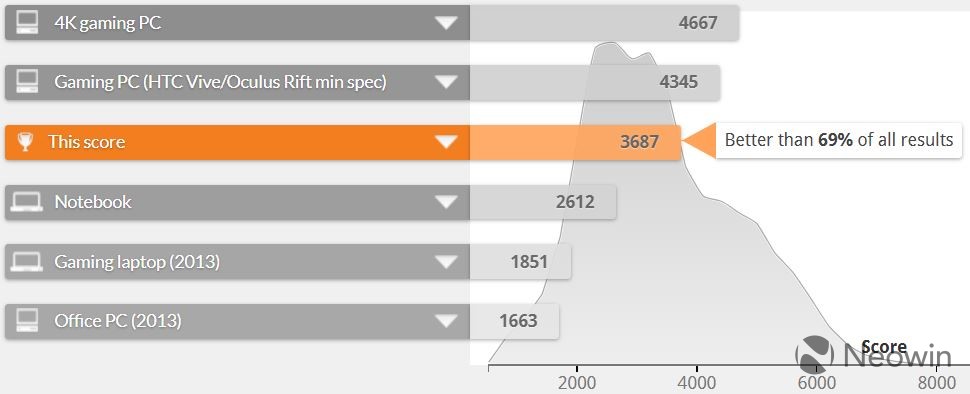




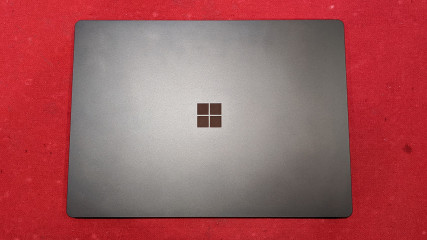
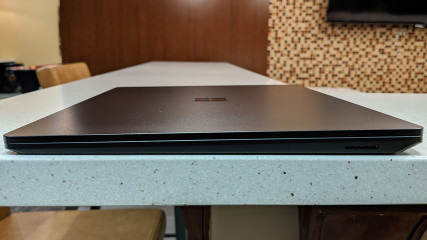
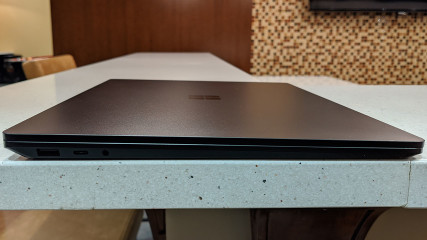
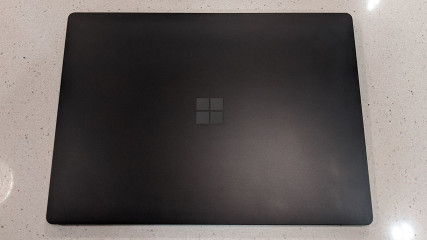
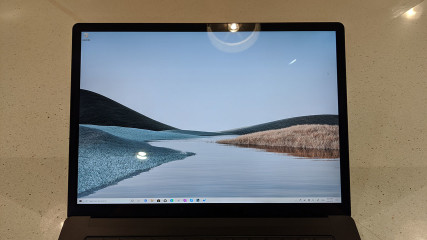
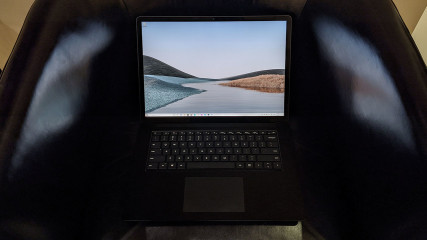
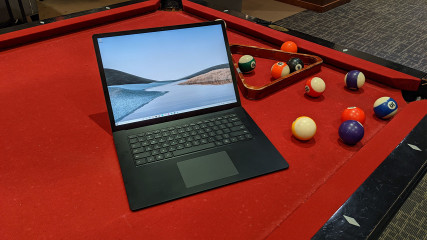
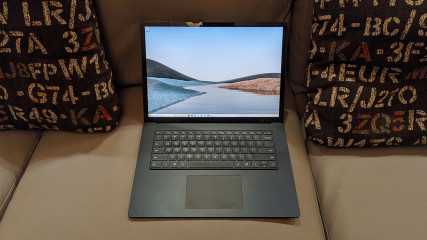
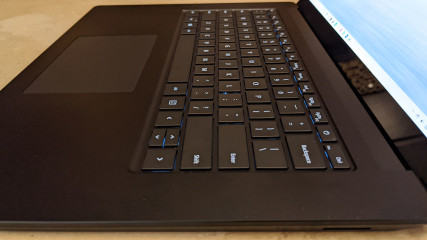
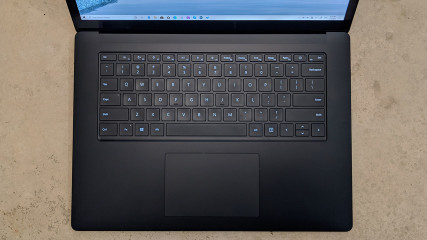
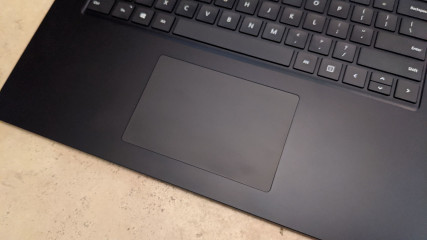

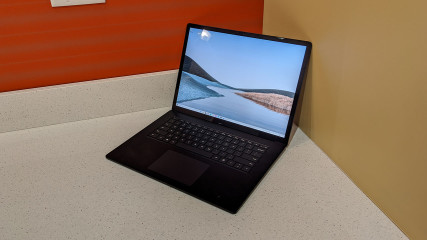
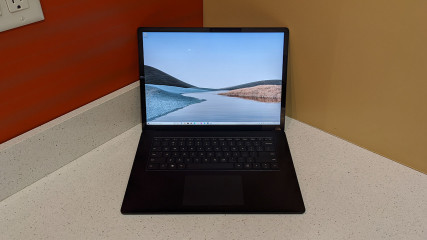
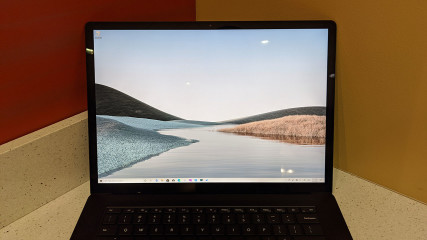
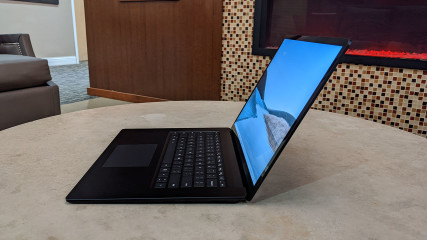









36 Comments - Add comment